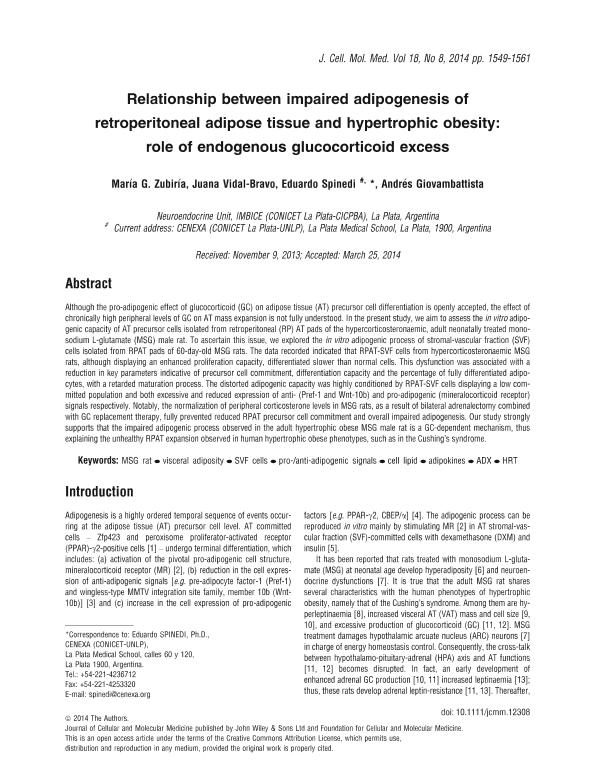Artículo
Relationship between impaired adipogenesis of retroperitoneal adipose tissue and hypertrophic obesity: role of endogenous glucocorticoid excess
Fecha de publicación:
08/2014
Editorial:
Wiley Blackwell Publishing, Inc
Revista:
Journal Of Cellular And Molecular Medicine (print)
ISSN:
1582-1838
e-ISSN:
1582-4934
Idioma:
Inglés
Tipo de recurso:
Artículo publicado
Clasificación temática:
Resumen
Although the pro-adipogenic effect of glucocorticoid (GC) on adipose tissue (AT) precursor cell differentiation is openly accepted, the effect of chronically high peripheral levels of GC on AT mass expansion is not fully understood. In the present study, we aim to assess the in vitro adipogenic capacity of AT precursor cells isolated from retroperitoneal (RP) AT pads of the hypercorticosteronaemic, adult neonatally treated monosodium L-glutamate (MSG) male rat. To ascertain this issue, we explored the in vitro adipogenic process of stromal-vascular fraction (SVF) cells isolated from RPAT pads of 60-day-old MSG rats. The data recorded indicated that RPAT-SVF cells from hypercorticosteronaemic MSG rats, although displaying an enhanced proliferation capacity, differentiated slower than normal cells. This dysfunction was associated with a reduction in key parameters indicative of precursor cell commitment, differentiation capacity and the percentage of fully differentiated adipocytes, with a retarded maturation process. The distorted adipogenic capacity was highly conditioned by RPAT-SVF cells displaying a low committed population and both excessive and reduced expression of anti- (Pref-1 and Wnt-10b) and pro-adipogenic (mineralocorticoid receptor) signals respectively. Notably, the normalization of peripheral corticosterone levels in MSG rats, as a result of bilateral adrenalectomy combined with GC replacement therapy, fully prevented reduced RPAT precursor cell commitment and overall impaired adipogenesis. Our study strongly supports that the impaired adipogenic process observed in the adult hypertrophic obese MSG male rat is a GC-dependent mechanism, thus explaining the unhealthy RPAT expansion observed in human hypertrophic obese phenotypes, such as in the Cushing’s syndrome.
Archivos asociados
Licencia
Identificadores
Colecciones
Articulos(CENEXA)
Articulos de CENTRO DE ENDOCRINOLOGIA EXP.Y APLICADA (I)
Articulos de CENTRO DE ENDOCRINOLOGIA EXP.Y APLICADA (I)
Citación
Zubiría, María Guillermina; Vidal Bravo, Juana; Spinedi, Eduardo Julio; Giovambattista, Andres; Relationship between impaired adipogenesis of retroperitoneal adipose tissue and hypertrophic obesity: role of endogenous glucocorticoid excess; Wiley Blackwell Publishing, Inc; Journal Of Cellular And Molecular Medicine (print); 18; 8; 8-2014; 1549-1561
Compartir
Altmétricas




